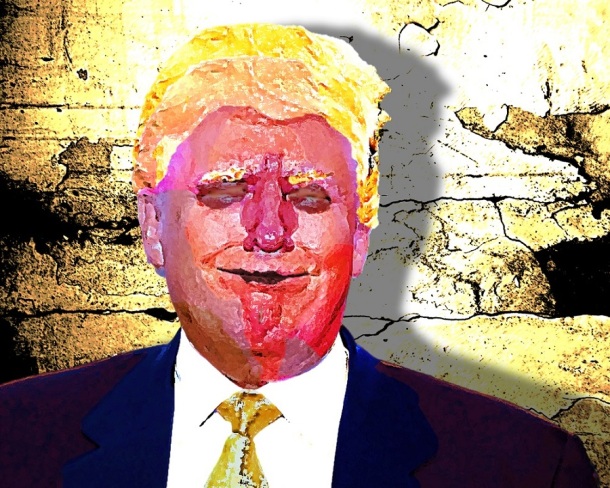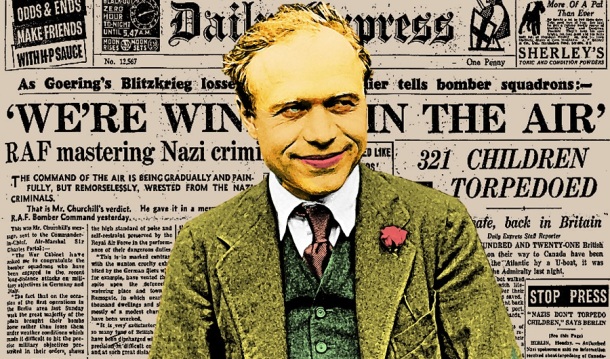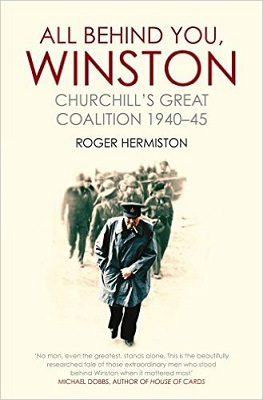A ruthless, charismatic tycoon who conducts his political office as if it were his own business; who holds court from his grand house in the nation’s premier city; who proclaims snappy slogans that capture the public imagination; and who enthusiastically supports the autocratic ruler of Russia.
Donald Trump didn’t break the mould of conventional politics – it had already been shattered over seventy-five years previously by William Aitken, 1st Lord Beaverbrook, the newspaper baron who was one of Winston Churchill’s closest confidants in the early years of the Second World War.
As the new president of the United States embarks on a predicted avalanche of controversial executive and legislative action to fire up his administration, there are loud echoes of how his fellow North American went about his task in May 1940.

Lord Beaverbrook – the colonial outsider from New Brunswick, Canada, and proprietor of the Daily Express and Evening Standard – was first and foremost a businessman. But politics ran a close second, and he always swung close to the establishment. Even before 1940 he had strayed significantly into Westminster, most notably during the First World War, when he joined Lloyd George’s government as the first ever minister of information.
He was hugely ambitious, possessed of a relentless energy, and was an inveterate pursuer of women. The parallels with Trump are many, although the great difference is that Beaverbrook could genuinely claim to be ‘self-made’. Nor was his motivation pure egotism: he was a lifelong pressman, launching his first newspaper at the age of thirteen.
Beaverbrook may not have been the leader of the ‘free world’, but his job in the spring of 1940 was crucial to European democracy’s survival. Churchill had appointed him minister of aircraft production, with the urgent task of building Spitfires and Hurricanes in double-quick time in order to take on the rampant Luftwaffe in the Battle of Britain.
The political class was hugely surprised and immensely sceptical when the new prime minister recruited his old friend to beef up the nation’s air effort. Much as ‘The Donald’ conducted his election campaign from the opulent Trump Tower in the heart of New York, so ‘The Beaver’ elected to run his department (at least in the first month or so) from his private residence, Stornoway House, an elegant six-storey townhouse overlooking Green Park. A former prime minister, Lord Grenville, had been a previous occupant, and Beaverbrook would later joke that ‘Grenville lived in Stornoway House and abolished the slave trade. I lived in Stornoway House in 1940 and re-established the slave trade at the Ministry of Aircraft Production!’
Beaverbrook certainly didn’t spare himself or his staff. Nor did he run his department like a trained administrator or politician; he ran it as he ran his business interests, off the cuff and with as much direct personal involvement as possible.
During the previous war he had pioneered the art of propaganda; now he brought it to bear on Whitehall itself. Trump’s knack with populist sound-bites and tweets has nothing on Beaverbrook’s command of the slogan. Over his desk in Stornoway House hung three dictums: ‘Committees Take The Punch Out Of War’, ‘Organisation Is The Enemy Of Improvisation’ and ‘All Things In War Are Simple, But The Simple Is Always Difficult’.
Evidence of his unconventional style could be seen throughout the building. Upstairs, secretaries and typists were forced to commandeer beds for desks, set up typewriters in the bathrooms, and answer a multitude of telephones that seldom stopped ringing. Downstairs, air marshals and representatives of every branch of the aircraft industry regularly filed in for interviews in the big bow-windowed library, where they would usually find the minister carrying on three conversations at once and, in spare moments, talking into his Dictaphone. Beaverbrook’s world was a ‘diverting comedy of bell-pushing, a loud harsh voice, and abrupt orders for men and papers’.
He had one overriding objective: to get planes built, and in the air, in the shortest time possible. The Royal Air Force had started the war with two excellent fighters, the Hurricane and the Spitfire. The question was whether the factories would be able to turn out sufficient numbers of these aircraft to replenish the losses that would soon result from the German onslaught. So Beaverbrook swiftly abandoned medium-term objectives, statistical planning and any rational allocation of resources. Success hinged on informality, spontaneity and inventiveness.
The political world has frowned on Trump’s appointees, who include a raft of fellow businessmen with little experience of Washington. So it was in May 1940, when Whitehall was left aghast as Beaverbrook pushed conventional figures in the aeronautics industry, such as Sir Wilfrid Freeman and Air Vice-Marshal Arthur Tedder, into the background, and instead recruited a group of industrialists who he trusted to apply the necessary drive, ruthlessness and know-how.
The most important of these brash newcomers – many of whom were past, or present associates of Beaverbrook – were Patrick Hennessy and Trevor Westbrook. Hennessy, an exuberant forty-two-year-old Irishman, had helped oversee a surge in sales as general manager at Ford Motors: ‘It was the most exciting time of my life’, he would later recall. ‘We broke all the rules’. Westbrook was a notoriously volatile character, who had been dismissed in March as general manager of the Vickers-Armstrongs airplane works at Weybridge, Surrey, after a quarrel with his director. But such was his standing among the 7,000 employees there that a brief strike broke out over the sacking.
Under Beaverbrook the ministry ran roughshod over Whitehall niceties. He formed action squads to enter likely stores of spare parts and remove them, despite furious protests from the RAF hierarchy. He commandeered aircraft to fly to France to pick up damaged engines and components for use in repairs. He even commissioned the Standard Motor Company to manufacture a light armoured vehicle – nicknamed the ‘Beaverette’ – to defend his factories.
All in all, he made the life of the air minister in the wartime coalition, the Liberal leader Sir Archibald Sinclair – the man in charge of the pilots who flew the Spitfires – absolute hell in that crucial period between May and September 1940. But his unorthodox methods worked. The Luftwaffe was seen off.

After September 1940, Beaverbrook’s stock started to fall, however, when he attempted to take on more conventional roles in the war cabinet. He made enemies easily and by the latter stages of the war the likes of the increasingly influential Clement Attlee and Ernest Bevin (who loathed him) had managed to largely sideline the Beaver from influence.
In the second half of the war the similarities with Trump continue, as Beaverbrook – much to Churchill’s annoyance – led the campaign in 1942 for a ‘Second Front’ in Europe, a cross-Channel invasion that would take the pressure off Stalin’s Russia. Much as Trump seems to admire the resolve and ruthlessness of Vladimir Putin, so the capitalist Beaverbrook extolled the virtues of brutal communist ‘Uncle Joe’, having been flattered and seduced by the Soviet leader on a visit to offer him tanks and guns from Britain for the Eastern Front.
It is easy to believe that Beaverbrook – always alert to technological innovation – would have thrived in the twenty-first-century world, where the news is increasingly driven by social media. His own equivalent of Trump’s tweets was the incessant flow of memos he dashed off to staff and colleagues, delivered to his secretaries via his favourite Dictaphone.
But unlike Trump, Beaverbrook – despite his supreme control of the Express and Standard – did not attempt to cow his own publications, nor the rest of Fleet Street. Indeed, he encouraged a bright new generation of young, left-wing writers – led by his protégé Michael Foot – to air their views prominently in his essentially Conservative-leaning papers.
Trump’s actions indicate that his first hundred days will be as hectic as Beaverbrook’s. The Donald has come to power in vastly different times and circumstances, but could the businessman’s instinct and autocratic methods again crash effectively through the jungle of political bureaucracy, just as they did in 1940? Or, despite his promise to ‘drain the swamp’, will Trump be out-manoeuvred by political insiders better versed in Washington power-play?
The new president has made great show of restoring Churchill’s bust to the Oval Office, but if he is to succeed – in his terms – then the Beaverbrook of May 1940 may be a better model.
Roger Hermiston’s latest book All Behind You, Winston: Churchill’s Great Coalition 1940-45 (Aurum Press) is now available in paperback.